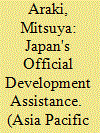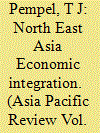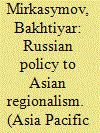|
|
|
Sort Order |
|
|
|
Items / Page
|
|
|
|
|
|
|
| Srl | Item |
| 1 |
ID:
082231


|
|
|
|
|
| Publication |
2007.
|
| Summary/Abstract |
Up until now, Japan's environmental cooperation with China has principally been in response to requests by the Chinese government, with Japan making major contributions in the areas of environmental policy, human resource development, and environmental management systems, and the construction of physical infrastructure. Unlike some other Western donors, Japan is heavily engaged in resolving various environmental problems throughout the whole of China, and these contributions will continue to play a powerful role in improving China's environment for many years to come. Moreover, Japan has also made a major contribution to the raising of environmental awareness among the general public throughout China, and has been instrumental in empowering Chinese environmental citizen's groups. Specifically, Japan has been providing the Chinese government with yen loans and technical cooperation, and has supplied it with many new concepts and mechanisms in the areas of environmental policy, management systems and physical infrastructure, as well. Japan has also provided a foundation for the development of China's environmental industry by means of technology transfer and human resources development. By supplying grant aid to different parts of China, Japan has played a pioneering role in the field of environmental protection in China, enabling the expansion of training and educational facilities and programs to which the Chinese government failed, due to putting a premium on a high economic growth, to allocate sufficient budget despite its awareness of the gravity of the problems that it faces. NGO environmental cooperation programs that use Japanese government grassroots and NGO grant aid and assistance of the Japan Fund for Global Environment have been highly significant factors in the resolution at the regional level of the serious environmental problems that have arisen throughout China. The role that these have played in intensifying exchanges and friendly relations at the grassroots level between Japan and the Chinese people has been highly commendable. In particular, environmental cooperation programs with China through the ten-year-old Sino-Japan Friendship Centre for Environmental Protection (SJC) have not been confined solely to solving China's environmental problems, and have accordingly helped to build a foundation for environmental cooperation with China's various neighbors and thus helped to enhance China's standing internationally.
|
|
|
|
|
|
|
|
|
|
|
|
|
|
|
|
| 2 |
ID:
082232


|
|
|
|
|
| Publication |
2008.
|
| Summary/Abstract |
This paper traces the history of Japan's Official Development Assistance centered in Southeast Asia through the decades from the 1960s to the 2000s. The characteristics of the "Japan ODA model" are examined and three conditions for economic growth generated by ODA are proposed. Whether or not the "Japan ODA model" is applicable in other regions is also discussed.
|
|
|
|
|
|
|
|
|
|
|
|
|
|
|
|
| 3 |
ID:
082233


|
|
|
|
|
| Publication |
2007.
|
| Summary/Abstract |
Japanese foreign policy six decades after the end of World War II stands at a crossroads. The forces of globalization and the rise of the BRIC nations (Brazil, Russia, India, and China) seem to herald the end of the unipolar post-Cold War international system and the emergence of a new era defined by multi-polarity and multilateralism. Such global trends are manifest most clearly in Japan's own backyard, where phenomenal region-wide economic growth, a gradual redistribution of power (in particular the rise of China and India), and the increasingly important role of multilateral cooperation and regional institutions are dramatically transforming East Asia. This trend shows no signs of slowing down, much less reversing itself; nor would it be in Japan's interest to pursue any policy that seeks to do so. Nevertheless, the transformation itself remains almost on auto-pilot, lacking a clear long-term guiding vision. After presenting a brief overview of Japan's past policy toward the region, the goal of this paper will be to articulate such a vision through a series of policy proposals through which to ensure future peace, stability, and prosperity in East Asia.
|
|
|
|
|
|
|
|
|
|
|
|
|
|
|
|
| 4 |
ID:
082238


|
|
|
| 5 |
ID:
082234


|
|
|
| 6 |
ID:
082235


|
|
|
|
|
| Publication |
2007.
|
| Summary/Abstract |
While the globalization of risks is commonly recognized, a corresponding global pattern of risk management has not arisen. For a while after 1989 the vision of a global community of states appeared to be coming true. Long-standing conflicts were settled, and the UN Security Council for the first time acted with consent and commitment in the area of crisis reaction. However, this short-lived phase of global conflict management was soon troubled, beginning with a cascade of secessionist disputes and ending abruptly on 9/11. Ironically, today's global crisis management seems to be more complicated and less promising than that of the Cold War with its comparably primitive bipolar structure. Some threats, such as arms races, nuclear proliferation, enemy images and Alliance-building, have returned. Frozen conflicts have been re-heated because of spreading ethno-political strife. New lines of confrontation have also emerged from transnational constellations. Nations and states are under pressure to cope with new risks at a time when both their competence and capability to manage societal change and adjust to globalization are under duress.1 While the responsibility2 of states to carry out crisis management in a turbulent environment is increasing, their operational capability is being challenged, from both top-down and bottom-up. Most states in the northern hemisphere feel sufficiently prepared to prevent conflicts between themselves and other states, but they are less well prepared for armed conflicts other than among states-so-called asymmetric wars. Where nation-state-based responses are insufficient and global responses out of reach because of disagreement among big powers, it is the regional level, which looks most promising for tackling these new challenges. But even if regional patterns function well, crucial questions remain. Might smaller states become the objects or victims of power politics in a region if it is dominated by champions? Would regional arrangements foster global fragmentation? How can the success of regional conflict resolution be transferred to the national level in cases of transnational risks, and is there anything that states can learn from each other in organizing regional security and state-to-state cooperation? Finally, should tools and strategies that have proven successful in one region be applied to others? This analysis compares state-based regionalism in (Western) Europe and (East) Asia. It accepts the premise that states can learn from each other, but argues that attempts at direct model transfer should be avoided.
|
|
|
|
|
|
|
|
|
|
|
|
|
|
|
|
| 7 |
ID:
082236


|
|
|
|
|
|
|
|